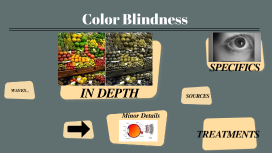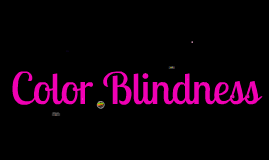Color Blindness Presentation
Transcript: Color Blindness IN DEPTH IN DEPTH A genetic condition caused by a difference in how one or more of the light- sensitive cells found in the retina of the eye that responds to certain colors. Typically it's an excessive overlap of the M (green) and L (red) color cones in the eye causing the obvious colors difficult to tell a difference between. Here you can view what it is like for the different types of colorblind. Simulation https://www.color-blindness.com/coblis-color-blindness-simulator/ Minor Details Little things to know... 1 https://iristech.co/statistics/ 1 1 in 12 men (87%) and 1 in 200 women in the world are diagnosed with color blindness https://www.colourblindawareness.org/colour-blindness/#:~:text=Colour%20(color)%20blindness%20(colour,200%20women%20in%20the%20world. 2 2 Majority of color blind people inherit it from their mother, although some people become color blind from other diseases such as diabetes. https://www.webmd.com/parenting/baby/newborn-vision#:~:text=Just%20after%20birth%2C%20a%20baby,is%20about%20a%20foot%20away. 3 Just after birth, a baby sees only black and white, with shades of gray. 1 week after birth children can see red, orange, and green. As they grow up they will slowly start to develop vision and start to see other colors such as blue https://www.bundoo.com/ Are you color bind? TEST <img src="https://images.ctfassets.net/u4vv676b8z52/6tpwrD6xE7eAVT48WiRO8G/af44a4b15a5833c1c570fa465d6b5004/ishihara-test-hero-compressor.jpg?fm=jpg&q=80" alt="Color blind tests: Do you see colors as they really are?"/> SPECIFICS What colors cause the most difficulties? Red- Green color deficiency is the most common form of color blindness because of the passing of the X- Chromosome from parent to child. Red- Green Blue and Yellow color deficiency usually effects men and women equally. This deficiency is caused by mutations in the OPN1SW gene. Blue-Yellow SO WHAT DOES THIS HAVE TO DO WITH WAVES? WAVES... Well, this is similar to wavelengths of sound. With shades of color, the length of the wave is directly linked to the resulting color. Long waves are seen as red tones, medium-length waves produce greens and shorter waves produce blues. Solutions to color blindness TREATMENTS Although there is no cure to color blindness yet, scientist are working on many different ways to cure this in the future. As of now there in only one real way that may help color blindness, since laser surgery isn't able to reach the cones behind your retina. Therefore that leaves us with our only current option...EnChroma glasses. EnChroma Glasses EnChroma Glasses EnChroma glasses are a very common type of treatment for color blindness. "EnChroma develops optical lens technology that selectively filters out wavelengths of light at the precise point where this confusion or excessive overlap of color sensitivity occurs. The M and L cones are altered in such a way that there is a greater amount of difference in color discrimination along the so-called “confusion line” for that individual."(Enchroma; The Science Behind EnChroma Lens Technology) https://enchroma.com/pages/how-enchroma-glasses-work https://moneyinc.com/enchroma-glasses/ These cost anywhere from 200$ to 600$. APA SOURCES Medlin Plus. (2020, August 18). US National LIbrary of Medicine. Medline Plus. Retrieved April 21, 2021, from https://medlineplus.gov/ Iris Tech; Statistics, Color Blindness Prevalence, n/d, from https://iristech.co/statistics/ Bailey, G. (2021, March). Color Blindness: Types, Causes, Symptoms, Treatment. All About Vision. Retrieved April 21, 2021, from https://www.allaboutvision.com/ National Eye Institute; (2019, July 3), Color Blindness. Retrieved from https://www.nei.nih.gov/learn-about-eye-health/eye-conditions-and-diseases/color-blindness#:~:text=Usually%2C%20color%20blindness%20runs%20in,have%20problems%20with%20everyday%20activities. Colour blind awareness. (ND). Color Blindness. Color Blind Awareness. Retrieved April 20, 2021, from https://www.allaboutvision.com/

















